Fiat Abarth: ‘right amount of wrong’
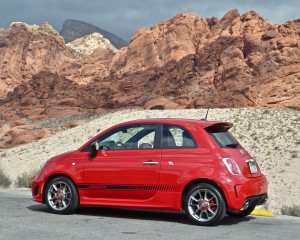
Stretched longer and housing power, suspension, interior and exterior upgrades, the Fiat Abarth costs $22,000.
By John Gilbert
Advertising can be coersive, exaggerated, informative, and meaningful, sometimes just annoying, other times fun. Then there are those special cases, where an ad can be so memorable it could only be improved if you could bring it to real life.
Fiat has pulled off one of those special ads, and it started with the Super Bowl and carried through to the introduction of the 2013 Fiat Abarth at the car’s introduction, in Las Vegas in early March. Fiat started to bring its subcompact 500 into the U.S. a year ago, and Jennifer Lopez did a series of memorable commercials driving the 500, but the little car drew some, but not a lot, of interest. Then came the Super Bowl.
The Fiat Abarth is a specially modified and turbocharged version of the new little subcompact 500 coupe, adding a new dimension to the 500 for Fiat, Italy’s expansive and technically savvy company, which now owns Chrysler Group. “The 500 is a fun, unique, agile, and cute car,” said Tim Kuniskis, the head of Fiat North America. “The Abarth is a 500 with just the right amount of wrong…It’s flirting with irrational, for $22,000.”
It’s not at all irrational if you thought the Fiat 500 needed a little extra dose of punch, because the Abarth has enough punch to satisfy discriminating performance-oriented drivers, whether on their daily commute, roaming on your favorite twisty roads, or taking advantage of a track-day at a local road-racing circuit. The question was, how to translate the special qualities of the Fiat Abarth, combining its practical side with its exotic Italian passionate heartbeat.
That made the Super Bowl the perfect launching pad for the Fiat Abarth, and it was a provocative ad that has continued, after turning out better than anyone could have imagined. The car comes in different colors, but because of the ad, you’ll have reason to picture it mainly in black.
As always, the Super Bowl was loaded with clever commercials, and sometimes they’re better than the actual football game. If you were normal — or at least a normal, red-blooded male — you undoubtedly remember the commercial where a normal-looking fellow is walking down a busy sidewalk, New York we’d guess, carrying a cappucino, or latte, or mocha, or some such designer coffee he has just purchased. Suddenly he stops in his tracks and stares, because ahead of him, bending over to adjust her high heels, is a stunningly beautiful, dark-haired woman in a provocatively flowing black dress with red trim. She glances back and catches him staring at her, and he freezes. She straightens up and confronts him, slaps him across the face, grabs him by the necktie and pulls him close to her. She reaches into his mocha-latte-cappucino thing and scoops out a fingerful of whipped cream. She puts it into her mouth, but a small bit of it falls, strategically plopping right where her discreetly plunging neckline is most discreet.
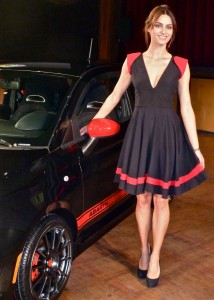
Catrinel Manghia repeated her prize-winning performance on Fiat Abarth TV ads at the Las Vegas media introduction. The car looked good, too.
The totally smitten guy is somewhere between shock and ecstacy, as he leans forward, slowly, eyes closed. We think he might attempt to lick up the fallen whipped cream, but as he leans forward, he opens his eyes to find that the most beautiful woman in the world has vanished. In place of his passionate objective is a new passionate objective — a Fiat Abarth, parked at the curb and wearing color-coordinated black paint with red accents.
When the seductive commercial first ran during the Super Bowl, Fiat’s website went instantly crazy. According to Edmunds.com, a widely accepted automotive news website, the Fiat showed an immediate increase of 3,354 percent in inquiries immediately after the Super Bowl ad aired — the largest increase of any of the many cars advertised during the game. Virtually all the hits were for the Fiat Abarth.
Since the Super Bowl, Fiat’s website has registered 8 million hits for the Abarth on Youtube, said Kuniskis, speaking at the news media introduction for the Fiat Abarth, in Las Vegas in early March. There have been more online requests for the Fiat Abarth since the Super Bowl than there had been, total, for the 500 itself in a full year.
Other company officials had already described how Karl Abarth was an Austrian who loved to make cars go fast. He moved to Italy around the time of World War II, and he became famous by building kits to transform normal production cars to far sportier and even race-worthy vehicles. He did it with a Fiat 500 back in 1959, when the little commuter car first was popular. I remember reading about “Fiat Abarth” race cars, and from afar, I guessed that somehow some company named Abarth did tricks with the exhaust to make the cars faster. I had no idea Abarth was a performance guru, nor did I appreciate the depth of his involvement. I even thought the name was “AY-barth,” when actually it is “AH-barth.”
Abarth continued to work with Fiat and raced the products of his handiwork, under the sign of the Scorpion — Scorpio. Now that Fiat is bringing the reincarnated 500 into the U.S., it is following up quickly with the Fiat Abarth. Those who think the Fiat 500 is a cute little thing, but would like a bit more spunk, have gotten their wish.
The sheet metal is the only thing that remains the same on the Fiat Abarth. They call it a track-ready, everyday performance car that gives you 34 miles per gallon. Suspension, engine, exhaust, interior, exterior, and everything up to and including a neat steering wheel with a flat bottom has been altered. Later, we went out and drove the daylights out of the Fiat Abarths on the Spring Mountain Park’s road-racing track just outside Las Vegas.
But before we left the presentation, Kuniskis had another surprise or two. First, he uncovered a specialty Fiat 500 Abarth that had been reworked and modified even more by parts-bin accessories, such as carbon-fiber body parts, lowered even more, and muscling up to over 200 horsepower with boost control.
At that moment, there was a bit of a disturbance in the hall where we were meeting, and out onto the stage stalked Catrinel Menghia — the same tall, stunning Italian woman from the commercial — wearing the same black dress with red trim. She accosted Kuniskis and challenged him. “You mean, this car is better than my car?” she demanded. Back-pedalling, the head of Fiat North America advised her to climb behind the wheel of the modified Abarth and try it herself. Now, the tuned exhaust of the Fiat Abarth is a force of exhileration on its own, snf it is enhanced even more with the dip into the parts-bin. She got in, and started it up. The sound brought a large smile to her face. And to the faces of everyone in the room, I must add.
It was the perfect touch for that press conference, or any press conference. Afterward, all the Chrysler and Fiat officials asked if they could pose for pictures with Ms. Menghia, and a lot of journalists tried to do the same. She knew her stuff, always making sure the little black Fiat Abarth was in the background.
The car had to be good to push itself beyond the presentation. If anything, getting out on the roadways to drive out to the track, and then getting on the track, were more impressive after that show-biz introduction.
Visually, the Fiat Abarth front end is pushed out 2.7 inches ahead to improve aerodynamics, increase the air intake ducts, house two projector-beam foglights, and also to make extra room for all the new hardware that is required to expand the 1.4-liter MultiAir engine to its more muscular and turbocharged status. A spoiller on the rear liftgate extends the roofline and creates added downforce for the front-wheel-drive pocket rocket.
MultiAir technology increases the 1.4-liter engine’s increases low-end power by 15 percent and also improves fuel efficiency by eliminating the intake camshaft and using the exhaust valves to actuate the intake valves by an electro-hydraulic system. Adding the single turbocharger that operates off the exhaust flow to spin u to 230,000 RPMs to drive a compressor that forces pressurized cool air into the intake chambers increases the engine’s power to 160 horsepower, and 170 foot-pounds of torque. The increase is actually to 150 foot-pounds, but clicking into Sport-mode gets it to 170.
Everything in the engine has been reinforced for more power — forged-steel crankshaft, lighter forged-steel connecting rods, cast-aluminum pistons with hard-anodized tops, and piston cooling jets at the bottom of each cylinder, encouraging the engine to run gleefully up to its 6,500-RPM red line, and 130 miles per hour. The extra firmness of the car’s handling never approaches harshness, and the extra power offers welcome response every time you want to hit the gas and run through the gears. It was also impressive on the road-racing track, where the Fiat Abarth snaked around the turns, and growled to high speed on every sstraightaway stretch.
“Engines trap air, and the best engines are the ones that trap air the best,” said Mike Vincent, chief powertrain engineer for the Fiat Abarth. “There are different ways to improve the ability to trap air — from pushrod engines, to overhead camshafts, to dual overhead camshafts, and to variable valve-timing. MultiAir infinitely alters the intake and timing, and the electro-hydraulic system makes for optimum valve opening, and the valves close when not needed.”
A 5-speed manual transmission puts the dynamic engine’s power to work, and the Fiat Abarth has reworked front suspension with 40 percent stiffer front spring rate, lower control arms and dual-valve Koni shock absorbers with frequency-selective damping, while the rear suspension also is 40-percent more rigid, with a larger rear stabilizer bar and 20-percent stiffer rear springs. Abarth-tuned steering increases response and feedback, and is 10 percent quicker. Larger brakes, 11.1-inch discs up front and 9.4-inch reardiscs, with semi-metallic lining helps stopping power.
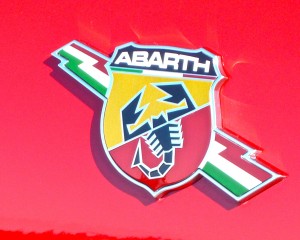
Scorpion logo gives instant identification to Abarth-modified Fiat 500, a commuter car at home on the track.
Abarth even adds an electronic stability control system with three-mode handling for all kinds of driving, with a simple On setting, a Partial-Off, and a Full-Off, which maximizes throttle performance during hard cornering. Fiat 500s for the U.S. are being built in Dundee, Mich., both in naturally-aspirated and Abarth form.
But you may have to go to Milano, or at least Las Vegas, to find Catrenil Menghia. Or you might spot her in action in the Abarth ads, although some have been revised to eliminate the spilled whipped cream. But the message still comes through.
Comments
One Comment on Fiat Abarth: ‘right amount of wrong’
-
quest bars on
Thu, 18th Feb 2016 8:42 pm
Thank you for some other informative site. The
place else may I am getting that type of information written in such an ideal method? I’ve a challenge that I am just now running on, and I’ve been at the glance out for such information.
(Thanks for the comment. Almost mystical! — JG)
Tell me what you're thinking...
and oh, if you want a pic to show with your comment, go get a gravatar!


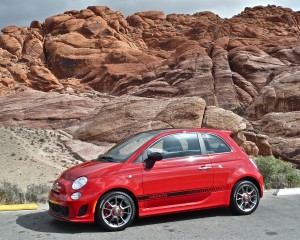
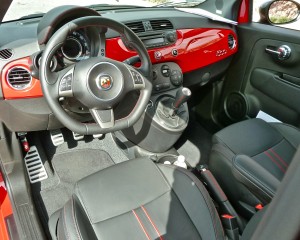
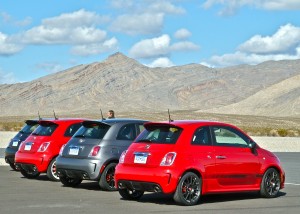
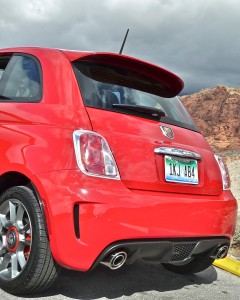
 John Gilbert is a lifetime Minnesotan and career journalist, specializing in cars and sports during and since spending 30 years at the Minneapolis Tribune, now the Star Tribune. More recently, he has continued translating the high-tech world of autos and sharing his passionate insights as a freelance writer/photographer/broadcaster. A member of the prestigious North American Car and Truck of the Year jury since 1993. John can be heard Monday-Friday from 9-11am on 610 KDAL(www.kdal610.com) on the "John Gilbert Show," and writes a column in the Duluth Reader.
John Gilbert is a lifetime Minnesotan and career journalist, specializing in cars and sports during and since spending 30 years at the Minneapolis Tribune, now the Star Tribune. More recently, he has continued translating the high-tech world of autos and sharing his passionate insights as a freelance writer/photographer/broadcaster. A member of the prestigious North American Car and Truck of the Year jury since 1993. John can be heard Monday-Friday from 9-11am on 610 KDAL(www.kdal610.com) on the "John Gilbert Show," and writes a column in the Duluth Reader.